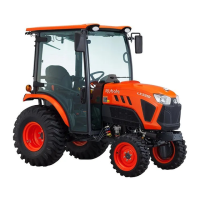the respirator in any way. Workers who use
tight-fitting
respirators cannot have beards/
mustaches which interfere with the respirator
seal to the face.
– If possible, change into disposable or washable
work clothes at the work site; shower and
change into clean clothing before leaving the
work site.
– Do not eat, drink, use tobacco products, or
apply cosmetics in areas where there is dust
containing crystalline silica.
– Store food, drink and personal belongings away
from the work area.
– Wash hands and face before eating, drinking,
smoking, or applying cosmetics after leaving
the exposure area.
5. Operating on slopes
Slopes are a major factor related to loss-of-control and
tip-over
accidents, which can result in severe injury or
death. All slopes require extra caution.
• To avoid upsets, always back up steep slopes. If
you cannot back up the slope or if you feel uneasy
on it, do not operate on it. Stay off slopes too steep
for safe operation.
• Driving forward out of a ditch, mired condition or up
a steep slope increases the risk of rear rollovers.
Always back out of these situations. Extra caution is
required with 4-wheel drive models because their
increased traction can give the operator false
confidence in the tractor's ability to climb slopes.
• Keep all movement on slopes slow and gradual. Do
not make sudden changes in speed, direction or
braking, nor make sudden motions with the steering
wheel.
• Avoid disengaging the clutch or changing gears
when climbing or going down a slope. If on a slope,
disengaging the clutch or changing gears to neutral
could cause the loss of control.
• Special attention should be paid to the weight and
location of implements and loads as such will affect
the stability of the tractor.
• To improve stability on slopes, set the widest
possible wheel tread.
(See TIRES, WHEELS AND BALLAST on page
90.)
Follow the recommendations for proper ballasting.
6. Driving the tractor on the road
• Lock
the 2 brake pedals together to help assure
straight-line stops. Uneven braking at road speeds
could cause the tractor to tip over.
ROPS model
(1) Brake pedal (LH)
(2)
Brake pedal (RH)
(3) Brake pedal lock
(A) “Lock the brake pedals
whenever traveling on the
road”
CAB model
(1) Brake pedal (LH)
(2)
Brake pedal (RH)
(3) Brake pedal lock
(A) “Lock the brake pedals
whenever traveling on the
road”
• Check
the front wheel engagement. The braking
characteristics are different between 2 and 4-wheel
drive. Be aware of the difference and use carefully.
• Always slow down the tractor before turning.
Turning at high speed may tip over the tractor.
• Make sure that the Slow Moving Vehicle (SMV) sign
is clean and visible. Use hazard lights and turn
signals as required.

